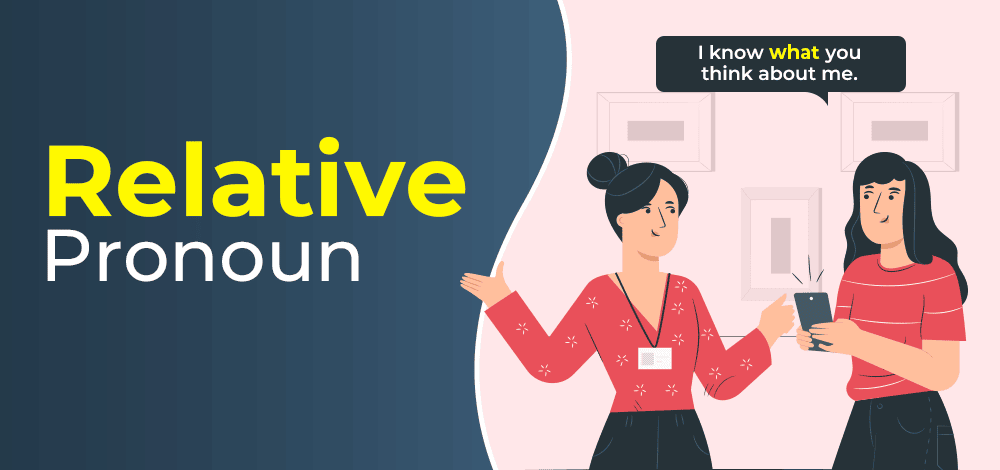Relative Pronouns | Basic Grammar for IELTS PDF Download
Relative Pronouns
A Relative pronoun is a type of pronoun that introduces a subordinate clause and relates it to the main clause. A clause beginning with a relative pronoun is poised to answer questions such as Which one? How many? or What kind? Who, whom, what, which, etc. In this article, we will explore the concept of relative pronouns, their usage, and the significance of the relative pronoun.

Understanding Relative Pronouns
- A relative pronoun connects two clauses, giving more information about the noun in the main clause.
- For example, "The book that I bought is on the table." Here, "that" is the relative pronoun.
- Example 1: The man who is standing by the door is my uncle.
- Example 2: Do you know the reason why she left early?
List of Common Relative Pronouns
- Who
- Whom
- Which
- That
- Whose
Relative pronouns are words used to introduce dependent clauses in sentences. They connect these clauses to the nouns or pronouns they describe. Here are some common relative pronouns:
- who
- whom
- whose
- which
- that
Examples of Relative Pronouns
In sentences, relative pronouns help provide additional information about a noun or pronoun. Here are some examples:
Who:
- The woman who is standing over there is my sister.
- He is the teacher who inspired me to pursue a career in science.
Whom:
- The student to whom the scholarship was awarded is very talented.
- The doctor whom I consulted was very knowledgeable.
Whose:
- The house whose roof was damaged is undergoing repairs.
- The company, whose products are highly sought after, experienced record sales.
Which:
- The book which is on the table is a bestseller.
- The laptop, which I bought last week, stopped working suddenly.
That:
- The car that I bought last month is very reliable.
- The movie that we watched last night was captivating.
- The car I purchased recently is highly dependable.
- The film we viewed last evening was enthralling.
How and When to Use Relative Pronouns?
Relative pronouns are typically used at the beginning of a dependent or adjective clause.
1. Use of Who
'Who' functions as a relative pronoun primarily to refer to a person and is utilized when the pronoun is the subject of a verb in a sentence.
- I know the man who did this.
- I am looking for someone who can do this.
2. Use of Whom
'Whom' is employed to refer to a person and serves as the object of a verb.
- He is the man whom, they say, the police arrested.
3. Use of That
'That' is used to represent people, animals, or things in various scenarios:
- We use 'that' with superlative adjectives. Example: Rini is the most annoying girl that I have ever met.
- We use 'that' with words like any, only, the same, none, all, something, etc. Example: This is the same shirt that I want.
- It is also used in interrogative sentences starting with wh- question words. Example: What is it that makes you so sad?
- When a person and an animal are mentioned together, 'that' is used as a common pronoun. Example: Reena and her dog that had trespassed on our lawn were turned out.
Usage of "That" and "Which"
- We use "that" with superlative adjectives. For example, "Rini is the most annoying girl that I have ever met."
- We use the pronoun "that" with words like any, only, the same, none, all, something, everything, nothing, etc. For instance, "This is the same shirt that I want."
- "That" is used as a pronoun in interrogative sentences starting with the wh-question word. Like, "What is it that makes you so sad?"
- When a person and an animal are mentioned in the same sentence, "that" is used as a common pronoun. E.g., "Reena and her dog that had trespassed on our lawn were turned out."
Use of Which
"Which" is employed to refer to non-living things and animals.
- Examples: The dog which they recently adopted is a Dalmatian. This is the dress which I bought yesterday.
Use of Whoever
- Whoever is utilized to refer to any person, acting as a subject pronoun similar to 'I', 'he', 'she', 'they', and 'who'.
- It points to the subject in a sentence, like in the example: "A gift will be given to whoever solves this problem."
Examples:
- The dog that they recently adopted is a Dalmatian.
- This is the dress that I bought yesterday.
Use of Whomever
- Whomever acts as an emphatic pronoun, functioning similarly to 'him', 'her', and 'them'.
- It is not utilized as an interrogative pronoun, as illustrated in the sentence: "I will appoint whomever you suggest."
Example:
- I will appoint whomever you suggest.
Use of Whichever
- Whichever can be employed to refer to animals or non-living entities.
- For instance, in the sentence: "You can buy anything you want.
|
18 videos|54 docs
|
FAQs on Relative Pronouns - Basic Grammar for IELTS
| 1. What are relative pronouns and what is their function in a sentence? |  |
| 2. Can you provide some examples of sentences using relative pronouns? |  |
| 3. What are some common relative pronouns used in English? |  |
| 4. How can relative pronouns be used correctly in sentences? |  |
| 5. How can I practice using relative pronouns in English sentences? |  |
















